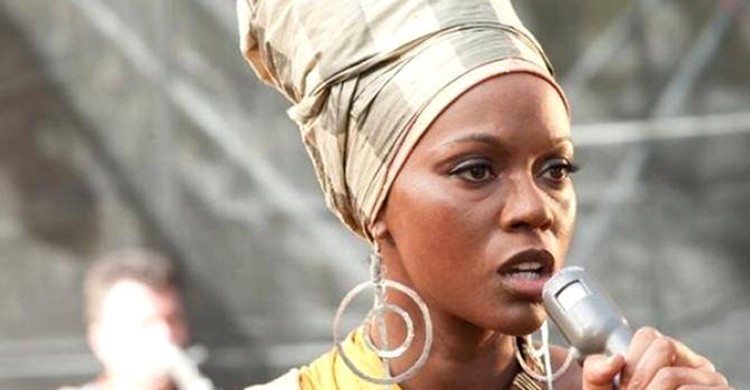Visibility in Suffering
by Akil Kumarasamy

The other month, Viola Davis became the first black woman to win an Emmy for her leading role in How to Get Away with Murder. In her acceptance speech, she quoted Harriet Tubman to highlight the current conditions for actresses of color in Hollywood: “The only thing that separates women of color from everyone else is opportunity. You cannot win an Emmy for roles that are simply not there.”
Early on as a young Julliard graduate, Davis learned the scarcity of jobs available to her as a black woman and the discrepancy between how she saw herself — “kind of funky and hip and quirky and shy” — versus how the industry saw her, which was “strong, authoritative and not pretty at all.” Only after decades of working in theater and in supporting roles for Hollywood did she receive a platform as a fully complex lead; besides her eight-minute screen time in Doubt, for which she received an Oscar nomination, it was her role as a Mammy in The Help that gave her national prominence. She imbued life into a caricature, and that she needed to play this type of character in order to receive national attention speaks to the conditions that actors of color face. For an actor of color, the roles available are often marginal and limited, and inside the white-walled film industry, there are only so many seats available for anyone who is not willing to match the stereotypical, reductive narratives Hollywood offers.
Whiteness presumes its own universality; it speaks for everybody. This never needs to be explicitly stated because we don’t question why after a zombie apocalypse most of the lead characters are white or why, in horror films, only white characters survive. It’s non-white stories that need to prove their universality. Fresh Off the Boat is billed as a show about Asian-Americans but with universal appeal. Are there any shows labeled as white that make an appeal to their relatability? Through this narrow lens of universality, shows and films like Girls and Boyhood are lauded for their realism. Girls, which is set in New York City, follows in the footsteps of Sex and the City, Friends, and Seinfeld, in that people of color are largely absent except for stock roles as the maid, the taxi driver, token black significant others. (Most responded to criticism for lack of diversity the same way, by including token black significant others: Donald Glover as Lena’s boyfriend on Girls for an episode, Blair Underwood as Miranda’s short-term boyfriend in Sex and the City, and Gabrielle Union and Aisha Tyler had similar love triangles with Ross and Joey in Friends). Boyhood is filmed over the span of twelve years in West Texas; the process was designed to capture reality itself. Though it is impossible to move around West Texas without bumping into someone with Mexican descent, maybe it’s not surprising that there is not a single person of color in the film except for Roland Ruiz, who plays a plumber. Instead of focusing on the problematic nature of Linklater’s depiction of the region, most critics have celebrated the aesthetic and technical feat of capturing a family with such accuracy over time. Perhaps when most reviewers are white males, the overwhelming whiteness or the relatability of the boyhood of the protagonist is never a relevant issue.
Whitewashing is a further limitation for actors of color. In the recently released film, Stonewall, queer people of color are given marginal roles in the 1969 rebellion that helped launch the gay liberation movement; even though black and Latino transgender women like Marsha P. Johnson and Sylvia Rivera have been credited with starting the riots, Hollywood recast the pivotal moment of the first brick being thrown with a white Midwesterner from Indiana. According to NPR, the director, Roland Emmerich, “says he wanted a white, male protagonist to serve as a relatable surrogate for the audience.” In the New York Times review of the film, Stephen Holden calls the whitewashing as “tantamount to stealing history from people who made it.” Whitewashing is defended by the idea that aestheticism and merit should be transcendent of race. This logic allows films like “Stonewall” to be marketed as historical but with crucial details changed — because when people of color don’t exist in the present or the past, it is easy to judge who fits the role.
Even in science fiction, the suspension of belief doesn’t necessarily mean racial reimagining, and though actors of color have appeared in the genre, their casting has often been met with public outrage (Thresh and Rue in the The Hunger Games, Human Torch in Fantastic Four). In J.J. Abrams’ upcoming Star Wars: The Force Awakens, British-Nigerian actor, John Boyega, plays a leading role as a Stormtrooper who joins the Rebellion. After the release of the trailer, the hashtag “BoycottStarWars” started to trend, as users commented on the film promoting “white genocide,” as if the appearance of a few actors of color dilutes the predominantly white male production of the film. Using the logic of the one-drop rule, these extremist fans have called the film “anti-white.” Even in a desert planet in a galaxy far, far away, actors of color are fighting to exist in the future.

Zoe Saldana as Nina Simone
Even when Hollywood promotes a blockbuster film with a non-white lead, there are very few actors who have access to these roles — Will Smith, Denzel Washington, Halle Berry — and Hollywood’s homogenizing methodology doesn’t discern cultural nuances. With the vigorous competition for these few roles and the possibility of effective whitewashing, ethnicity becomes a vague category. In Selena, Jennifer Lopez plays the iconic Mexican-American singer, and maybe the fact she is a Puerto Rican-American woman shouldn’t matter, especially when Warner Bros. wanted to cast a non-Latina actress, but that means as a Mexican-American actress, even when a role might be perfect, you still don’t have a chance. Understandably, actors of color who already have visibility in the mainstream want to maintain their platform. For Hollywood, these select few become representatives for diversity; they are able to play lead roles outside the usual tropes for people of color, while the rest as Viola Davis pointed out on Oprah’s Next Chapter, are on “crisis mode” competing over a “piece of cheese.” Competition is the implicit consequence of the narrow and reductive roles available. What choice do actors of color have except to play the game and start running for a seat?
There is a myth that talent rises to the top regardless of barriers. In the case for acting, a role must exist in order for an actor to demonstrate his or her abilities. The question is how long must you wait for a role to come around that allows you to show the range of your skills — or will you die before you even have that chance? During the 2009 Screen Actors Guild awards, Meryl Streep, in reference to her Doubt co-star Viola Davis, called out from stage, “My God, somebody give her a movie.” For an actress as talented as Viola Davis to be overlooked for decades feels both devastating and familiar as the appeal by Meryl Streep is both urgent and inert. White actors are able to have full careers in the movie industry, receive lifetime achievement awards for a variety of roles they have played from their twenties to their seventies. But from the beginning what most actors of color have are slim pickings, a career built out of the hunger for work and just plain hunger.
The release of mainstream Hollywood films that feature leading black actors in expected roles like in The Help, The Butcher, 12 Years a Slave, grants many actors of color visibility, but reinforces how Hollywood permits mostly narratives of black suffering which rely on the crux of white kindness. In a more recent film, Selma, directed by an African-American woman, Ava DuVernay, focuses on Martin Luther King Jr. during a crucial moment of the Civil Rights Movement and pushes against national narratives about Martin Luther King Jr. and President Lyndon B. Johnson. DuVerney depicts a contentious relationship between the two men, specifically delineating the reluctance of President Johnson to pass voting rights legislation. Many critics have called DuVerney’s depiction of President Johnson as misleading. In writing about Selma for Time magazine, David Kaiser said, “Even in this one — and especially in this one — accuracy matters.” It is interesting that accuracy seems to matter most in narratives that push against white-savior depictions while whitewashing has become deeply entrenched in the American narrative. Meanwhile in television shows like Homeland, Muslim characters are interchangeable and dangerous, always within the mainstream narrative of them as terrorists, while the Middle East and South Asia are portrayed as no more than single set-pieces of despair and violence. (Artists were hired to paint Arabic graffiti to make the Berlin set more reminiscent of a Syrian refugee camp. They scrawled phrases like “Homeland is racist” and no one on set even noticed.) In the 2015 Oscars, a film like Selma, which did not align with popular opinion, received two Oscar nominations while American Sniper, an ode to American warfare, received six nominations, including for best lead actor (no actors of color received nominations).
The difficulty to garner critical acclaim makes it understandable why actors of color might accept transformative roles that might lead to an Emmy or Oscar, even if these roles might be best suited to others who more closely fit a character profile. In 2013, Zoe Saldana was cast as the actress to play Nina Simone in a biopic about the singer and activist that will be released later this year. For the film, she darkens her skin and wears a prosthetic nose, which further speaks to a narrative of white minstrelsy, and the effect makes one wonder what Nina Simone, who had spent her career championing against Hollywood’s standards of beauty, would have thought. In an interview with HipHollywood, Zoe Saldana responds to criticism of her casting and says she is playing this role for all her sisters. In essence, she is playing Hollywood’s representative rather than allowing a realistic representation, a concern white actors don’t need to face — they are never in danger of becoming representations of their ethnic/racial background. In this game of musical chairs, there are only so many seats available, and even if Zoe Saldana did want another sister to play the role, where would she be?
